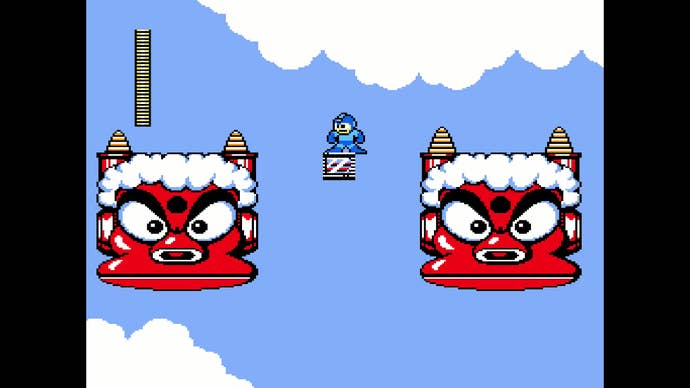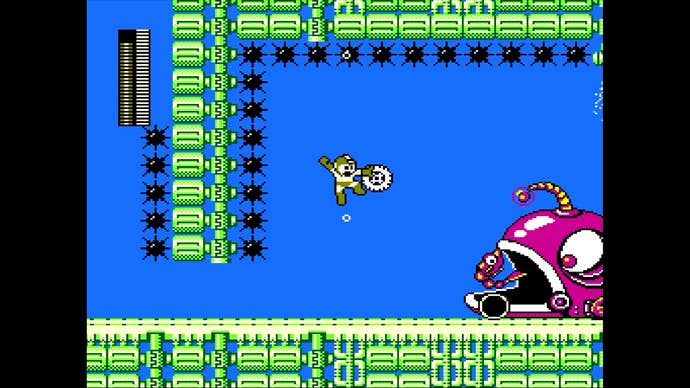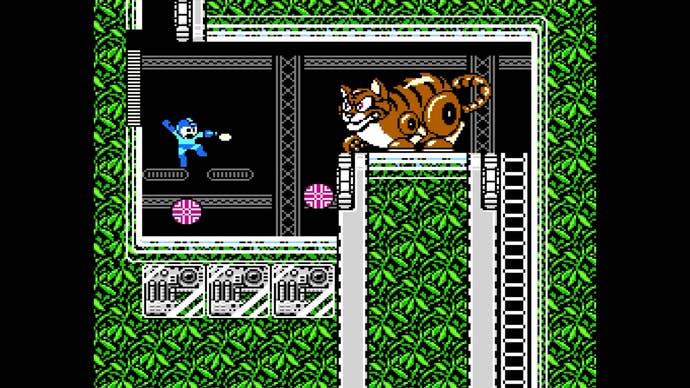Mega Man Legacy Collection Xbox One Review: The Robot Museum
Finally, six NES classics get the treatment they deserve. But is less truly more?
This article first appeared on USgamer, a partner publication of VG247. Some content, such as this article, has been migrated to VG247 for posterity after USgamer's closure - but it has not been edited or further vetted by the VG247 team.
Jeremy Parish, Editor-in-Chief
The first time I kissed a girl — my first real, teenaged, hormone-driven, let's-go-for-it kiss, the kind that makes your jaw ache the next day — happened early in ninth grade. As it happens, I played my first Mega Man game (actually the first Mega Man game) just a few months before that, in that lazy summer interim between eighth and ninth grade.
I mention this not because these facts are related (they're not, and that would be weird), but rather to make a point: I've literally grown up with Mega Man. I discovered the series just before making that perilous leap from childhood into adolescence (followed all too swiftly by adulthood), and my interest in the games remains one of the handful of things to have weathered that transition in my life. After that fateful kiss, I lost interest in an awful lot of things... but not, as time (and probably a quarter-million words of articles and blog posts) have demonstrated, Mega Man.

So it's fitting, I think, that just as I've grown up with these Mega Man games, they sometimes grow up with me, too. With the Legacy Collection, Mega Man echoes my growing interest in the way classic games are displayed, preserved, and curated. It makes sense, given that this project was overseen by Digital Eclipse's Frank Cifaldi, whose outlook on and work for the science of game preservation has helped inform my own thoughts over the years. (Disclosure: Cifaldi and I worked together at 1UP.com; you can take this as a sign of games journalism collusion, or you can simply read it as a sign that video games are a small industry and people with similar interests and obsessions invariably cross paths.)
The last big Mega Man collection — 2004's Anniversary Collection for GameCube and PlayStation 2 — was one of the first game collections to make me pause and say, "No... this isn't quite right." At the time, I had a difficult time putting my finger on what precisely bothered me about MMAC, but minor complaints like the backward button mapping in its GameCube version ultimately pointed to the bigger issue: It simply didn't do the games justice. It was OK, but I haven't played through Mega Man 2 more times than I care to admit because it's merely OK. I loved the game then and love it now because it's a masterpiece of design: Visually imaginative, cleverly arranged, and aurally phenomenon. It deserved better than the soft visuals, bungled controls, and faint input lag of MMAC.
It's taken a decade, but Mega Man Legacy Collection finally presents these games with the clarity, fidelity, and reverence they deserve. It offers a nearly perfect recreation of six NES classics running on modern hardware, absolutely demolishing any other reproduction I've played of the games since they debuted. It fixes the dim colors of Wii Virtual Console, the fuzziness of Wii U Virtual Console, the distorted pixels of the 3DS version, the clunkiness of the PlayStation remakes, and the numerous flaws of the Anniversary Collection. It also avoids the stuttering frame-skips that I've noticed on emulators like the RetroN 5. In fact, the only more faithful rendition of these games I've ever encountered is to play the original carts on actual RGB-modded NES hardware... and considering MMLC costs $15 versus the "authentic" option's $800, that makes it kind of a no-brainer.
I realize, however, that developer Digital Eclipse's approach to MMLC won't be to everyone's liking. They've taken the "less is more" philosophy with this compilation, and the prevailing sentiment in games is "give me more for less." It arrives on the heels of Rare Replay, which cost twice as much and offered five times as many games, all reproduced nearly as well (if not quite so consistently) as MMLC. But Rare Replay is, fittingly, a rare exception to the rules of compilations, which generally sacrifice the quality of reproduction for sheer numbers. MMLC goes the other direction, offering a few games presented with nearly exhaustive detail and fidelity (and for a budget price), essentially making this compilation the first time the U.S. has received a package equivalent in concept and quality to the Sega Ages collections developer M2 produced for Sega of Japan on PS2 — a set of roughly half a dozen releases that I hold as the gold standard of game archiving. That same spirit lives on in the 3D Ages titles for 3DS (most recently Gunstar Heroes), and it's nice to see it make its way beyond the borders of Sega and M2.
Admittedly, MMLC isn't entirely flawless, and it's not quite as exhaustive in its scope as those vaunted PS2 import compilations. But it comes remarkably close, and given the poor treatment Mega Man has suffered in recent years, that's doubly surprising. Besides the simple fact that MMLC allows you to play six nearly perfect recreations of the NES games, the package also includes a ton of options and extras. You can display the graphics with emulator-style crispness, with simulated scanlines equivalent to a high-quality CRT monitor, or via a "television" mode that introduces a number of graphical artifacts to simulate the visuals of the consumer-level CRT televisions we old-timers used for playing these games in their original incarnations. MMLC should satisfy the 1080p/60fps fetishists, with the only slowdown on display being an artifact of the original games. By default, the games output at what appears to be 960p with a border (presumably to produce the cleanest possible graphics — 960p is exactly four times the NES's 240p signal), but you can resize the visuals to a full 1080p vertical resolution... or even stretch the graphics to fit a full widescreen television, if you have no sense of decency at all.
All of this, of course, amounts to fussy particulars that make me happy but which most people won't care about. The more important question is, "Are the games themselves any good?" Yes, absolutely. The original Mega Man trilogy in particular stand among some of the greatest 8-bit action games of all time, and they still hold up remarkably well (despite the first game's rough edges, glitches, and occasional moments of sloppy balancing). Before the Super Mario Bros. 3 versus Super Mario World debate, there was Mega Man 2 versus Mega Man 3. They're fast, imaginative platformers with perfectly responsive controls and an open-endedness that makes them wonderfully replayable.

The idea of allowing players to tackle any of the game's first eight stages (six in the original Mega Man) was a stroke of genius that still has yet to be topped in terms of clear, accessible player choice. Defeating each of the bosses at the end of a level rewards you with a new weapon that both alters your play style throughout a stage and dishes out extra damage to a boss at the end of a different level. The initial appeal of a Mega Man comes from figuring out which of the bosses you can beat with just your basic gun, and who is weakest to each new weapon you acquire. In subsequent playthroughs, the thrill comes from using this knowledge to refine your approach or simply mixing things up to try new challenges.
Supplementing the game's fundamental hook to play forever is a collection of dozens and dozens of custom challenges, ranging from simple fights against a specific boss to difficult chunks of multiple stages strung together in sequence. Some of these are simply a task to complete (though, ever faithful, the first game's pause trick does work against the Yellow Devil), while others are much easier and simply demand you outdo countless other practiced Mega Man fans to earn the best time on each system's leaderboards. Admittedly, I didn't spend as much time with the challenges as I'd like, as I reviewed the game on Xbox One. To use the ever-popular steak metaphor, playing these games with the Xbox One's controller is like eating a steak through a straw... but I'm certainly looking forward to putting in some serious time with these events once I pick up the PS4 version.
And finally, MMLC includes tons of character and concept art, full manual and packaging scans, and a fully-translated database from the Japan-only PlayStation remasters. The latter is a completely ridiculous feature that provides utterly exhaustive information on even the most minor enemy robots, but it's a great sign of just how much affection these games' creators poured into them.

MMLC also offered me an opportunity to revisit and reconsider some of the Mega Man games I've spent less time with. Playing Mega Man 4 in this context, for example, finally helped me pin down why it's probably the worst entry in the classic Mega Man platformer franchise (it's bogged down with cheap gimmicks and poor level design). It also gave me a better appreciation for Mega Man 5 and 6, games I had skipped back in the day because I thought I was burned out on Mega Man. Turns out I wasn't; Mega Man 4's mediocrity had simply soured me on the series. But taken on their own merits, the fifth and sixth entries are pretty solid after all.
All of this being said, there are a few things that could have made MMLC the perfect, complete, ultimate Mega-Man-on-NES package. It would have been great to be able to use the controller's shoulder triggers to cycle through weapons as in previous compilations. I would like to have seen versions from other regions for the sake of completeness. I wish they could have found a way to sneak in Japan-only Famicom board game Rockboard, even as a hidden bonus, just to make this a truly comprehensive 8-bit package. Or remakes like The Wily Wars, a rare and expensive remix of Mega Man 1-3 for Sega platforms. And given that all my nephews and young cousins know and love Mega Man because of his appearance in Smash Bros. 4, the lack of a Wii U version is beyond baffling.
But none of these things are crucial oversights, and whatever is lost by their absence is more than made up for by the exceptional quality of the overall collection. We've reached a point at which classic video games have been badly devalued by ROM hoarding and all-you-can-eat compilations of middling-to-poor quality. Mega Man Legacy Collection makes a striking argument for the case that these classics do indeed have value, and that their worth becomes self-evident when presented with such tremendous care. Certainly that's been my perspective for quite some time now, and there's something personally satisfying about seeing the case being presented through a franchise that's been so dear to my heart for so long.
Mike Williams, Associate Editor
There's a weird juxtaposition that happens in Mega Man Legacy Collection from the first time you load it up. You're faced with a title screen that uses high-resolution art alongside a font that's meant to mirror the original font used in the 8-bit games. That's a solid metaphor for Mega Man Legacy Collection, the best of the past, mixed with the technology of today.
For me, MMLC has been a trip down nostalgia road. A trip where I stopped to take a breather early in my travels, got mugged, and lost my rose-colored glasses. My plan was to play all the games in order, seeing how Mega Man evolved over the years. Right from the beginning, Mega Man 1 was a harsh slap in face, a game that did not play around in any way, shape, or form. The level design is rougher than Mega Man 2 or 3, and some of the bosses — hey, Elec Man! — are painfully hard without their specific weapon. The first game makes the subsequent sequels feel easier.
Mega Man 2, 3, and 4 were largely what I remembered from my childhood and my brief time with the Mega Man Anniversary Collection for PlayStation 2. (I was more of a Mega Man X fan.) These are still amazing games, though Mega Man 4 trails along behind the others, despite introducing the charge shot into the series for the first time. Realizing which games introduced certain ideas to the series was also a bit of a shock, as I figured the charge shot came earlier than 4, and I thought Rush had debuted in Mega Man 2 for some reason.
I was also surprised with how much I don't remember Mega Man 5 and 6. Did I not play them as a child? No, because I vaguely remember Gravity Man, Napalm Man, Tomahawk Man, and Blizzard Man, but for the life of me, nothing from those games stuck with me as a kid. For adult Mike, playing 5 and 6 was largely an experience in discovery. Sadly, that discovery wasn't a pleasant one; both of the latter titles felt exploitative and phoned-in, releases created just to keep a brand alive. A quick Google shows Mega Man to be one of the original annual franchises — the more things change, the more they stay the same — and it shows.

The entire Mega Man nostalgia parade is joined by a whole host of options and additional content. You have a single save state per title, the ability to play the games in their original resolution or stretched versions, an odd TV filter if you want to feel the pain of ghosting images on your big-screen, a ton of character art, and bios for every enemy in each title. Most of the options you can access on the fly by clicking the Dual Shock 4's touchpad, and jumping between titles is a breeze. If you just want to play old Mega Man games, developer Digital Eclipse has delivered the most authentic experience possible.
That wasn't enough, though. They also added challenges, which stitch together different bits of Mega Man levels via portals. You're tasked with finishing each level under a certain par time. These are a ton of fun, jumping from level-to-level within various themes: single-game remixes, boss rushes, and multi-game mashups. The early challenges are baby steps that unlock the longer, harder levels, and once you finish a challenge you can watch a replay of your best time to see where you screwed up and where you can improve. The best times for each challenge end up on the Top 20 leaderboards, so you always have a pinnacle you have to conquer.
Challenges are the magic, folks. They are heaven and hell. Fun and frustration. There's around 50 in total, but I'm hoping Digital Eclipse lets some people get in there and create other challenge levels. A nice infusion of new challenges is just what Dr. Light ordered for this collection.
If you love Mega Man, buying Mega Man Legacy Collection should be a foregone conclusion. This is Mega Man 1 through 6, exactly as you remember them, with a whole bunch of additional content for Mega Man buffs. All for $15. That's like stealing a power from Capcom Man.
InterfaceWhile not all modern controllers are ideally suited for this style of game (ahem, Microsoft), both the controls and front-end for MMLC are excellent
Lasting AppealSix endlessly replayable games, dozens of challenges.
SoundPretty much indistinguishable from Capcom's official soundtracks. I noticed a couple of sound effect glitches, but they were fleeting and minor.
VisualsPerfectly reproduced, all the way down to the flicker when the NES chip barfed on too many sprites, and with ample display options to suit any tastes (no matter how poor).
ConclusionBy far the best and most impressive Mega Man compilation ever assembled, what Legacy Collection sacrifices in reach it more than makes up for with refinement. It presents six games almost (though not quite) flawlessly, while providing enough display options to satisfy the obsessive and casual fan alike. Add to six beautifully preserved classics a massive database and dozens of addictive custom challenges and you have an excellent package that treats the classics with the respect they deserve — something that's traditionally been absent in the U.S. market. A must-have for any Mega Man fan.









